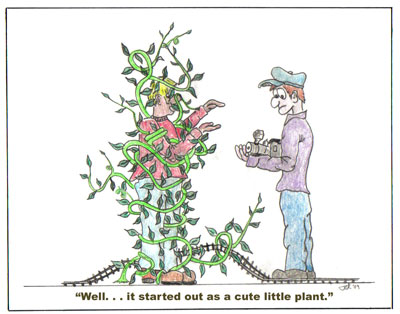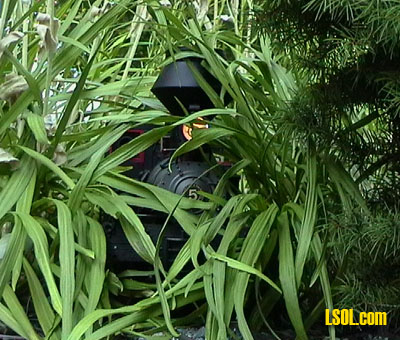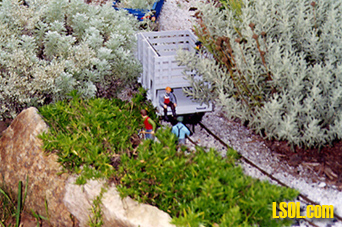Plants
Plant Selection Basics For Outdoor Layouts
Mar 24, 2010


By Tom Knight |
Author
Bio
Yeah they all do. Start out as cute little plants. Just as we all started out as cute little babies. NOW look at us. It amazes me how some folks start out with the idea of a "garden" train layout and wind up with "weed" train layout or a "desert" train layout (to avoid weeds!)
|
Yea they all do. Start out as cute little plants. Just as we all started out as cute little babies. NOW look at us. 
Interested in getting this on a shirt or bag? Check out Trains in the Garden Gear. More gear coming soon! It amazes me how some folks start out with the idea of a "garden" train layout and wind up with "weed" train layout or a "desert" train layout (to avoid weeds!) Now I know none of us started into this hobby or acquired this addiction with the idea of becoming gardeners. Trains come first. That is understood. BUT if an old salty model railroader would take just a little time to give some thought to plant selection . . . well then their layout might look just a spiffy as the detail on their engines, rolling stock, or structures. 
Photo by: Pete Briggs - The U-25B ST #21 is seen cutting through (or plowing) Phlox that had over grown the right of way on the Suleski Transportation.
Don't get me wrong. I have seen some layouts that look like the National Arboretum. Some folk's plants make a professional Japanese bonsai artist blush, but for the most part, outdoor layouts lack something to be desired when it comes to plant selection and maintenance. Maintenance will be another topic. This go-around I want to talk about plant selection. 
Suleski Transportation Maintenance of way crews working to cut back growth along a branch line that only sees seasonal use. Before we begin lets have a "little" botany lesson on plant names. Now most folks just call plants by a simple name like "holly", or "maple", or "that thing over there". Some get a little more sophisticated and go as far as saying "American holly" to Japanese maple". That is okay but when you get down to the nitty-gritty of plants there are several types of American hollies and hundreds of different Japanese maples. Some of which would be good for an outdoor train layout and some not so good. To better help resolve the identification of plants botanist came up with a naming system called the "Binominal System of Nomenclature" Impressive isn't it? Well what it means is that any plant is given two names (bi + nominal = two names). This name is collectively referred to as the Specie name. For example a Japanese maple by it botanical/binominal name is Acer palmatum.
Now most of you could really care less about such naming but my point is that if you look a little closer (as I said before) there are hundreds of different types of Arce palmatum plants. SO the botanist came up with a further refining of naming plants and the "sub-specie" name classification of cultivar was created. Now you might have an Acer palmatum cv. Ruby Lace. Or a Ruby Lace Japanese Maple by common name. So you might say. . . "BIG Deal Mt Knight!" Well there can be a huge variation of physical characteristics of the cultivars within a given specie. For example one cultivar might grow to a mature height of 15' while another might get only 3' in height. My vote would be for the 3' plant on a large scale train layout. Just to have something more "to scale". One more example might be that one cultivar (plant A) might be hardy enough to live only on climatic zones 7 and 8 (southern zones) while another cultivar of the same specie might be hardy from zone 4 to zone 8 (plant B). What this would mean is that plant A should not be considered in northern climates. It wouldn't survive the winters. Stick with me as I start to introduce you to plants that are best for your railroad and as we grow our Plant Profiles section of the LSOL.com Library.
| plant selection |
| What would be really helpful is a spreadsheet type of table that listed plants by groups with common name, specific latin name, growth characteristics, zone tolerance, and some commentary. Would be even better if it could be accompanied by a photo of the mature plant so we could go and negotiate with our local friendly nurseryperson. I'd buy it in a flash, especially if it were online and constantly update. |
| Mike Evans - 03/24/2010 - 06:39 |
| trees on my rail road |
| Tom I joined The Long Island Bonsai Society to learn how to care for and trim my trees to scale. It is another hobby all by itself. I learned how to make a mini forest with trident maple trees and I have two on my rail road. Like you said you have to learn what you can grow on your rail road so it doesn't get to big. |
| Steve Borakowski - 03/24/2010 - 15:29 |
| Garden Railway via Master Gardener |
| I came into outdoor railroading by way of Garden landscaping, not the other way around. I'm a Master Gardener, so the Garden is a priority. The Kids are gone so no longer need the playground areas so it was time to redo the landscaping - 3000 gal fish pond with a berm for a waterfall, what about a couple of tunnels through the berm for a train around the pond? Welllllll as long as were doing, how about a village? Wellllll.... just kept growing, Now I've built a shop in which to build the structures, people, house the power packs and store the trains. Now if I could just figure what I'm doing in the electronics department. |
| Gerri Miller - 03/25/2010 - 06:57 |
Top of Page
|



